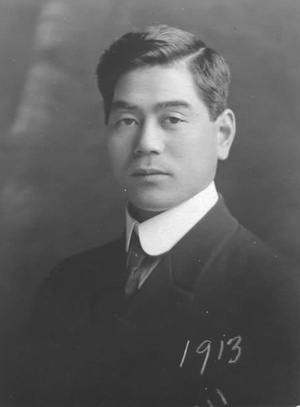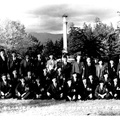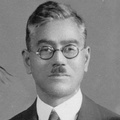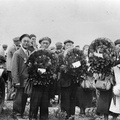*From notes by Sada Shinobu
Saburo Shinobu was born Saburo Takahashi on August 25, 1888 in Sanuma, Miyagi-ken, Japan. When he married Sada Shinobu (of the nearby town of Ishinomori) in Japan, he took her surname, as she was descended from a prominent samurai family.
He emigrated to Canada, arriving in August 1907 alone at the age of eighteen. He studied English in a public school in New Westminster, British Columbia (starting at the grade 4 level), with much younger classmates. A census page indicates that he was living with the family of his wife’s uncle, Chiyoji Shinobu, in 1911. He graduated from King Edward High School in New Westminster, in 1913. Saburo and his fellow Japanese students Kosaburo Shimizu and Shinji Fujimoto had raised money to purchase books for the high school library. Photo A is his graduation photograph. He worked as an interpreter and manager at several organizations in Vancouver and Prince Rupert. He prospected on the Queen Charlotte Islands (now Haida Gwaii) for copper with his friend, entrepreneur Arichika Ikeda, who later established a mine at Ikeda Bay.
In 1917, he became secretary of the Canadian Japanese Association in Prince Rupert, BC. He took an oath of Naturalization on May 26, 1917, a few months before his wife Sada moved to Canada. He worked in Prince Rupert for two more years before moving to Vancouver to work at the head office of the Association to help Japanese Canadian soldiers who had been sent to World War I. 225 Japanese Canadian volunteers served in WW1 as part of the Canadian Expeditionary Force. They participated on the Western Front in Europe in 1917 and 1918. Fifty-four were killed on the battlefield or died as a result of their wounds, and most survivors were wounded. Many Japanese soldiers fell at the Battle of Vimy Ridge. Eleven were awarded Military Medals for Bravery.
When the soldiers returned from overseas, Saburo worked tirelessly for their rehabilitation, as interpreter, go-between, and consultant.
He gave a speech in English at the unveiling of the Japanese Canadian War Memorial in Vancouver on April 9, 1920, the third anniversary of the Battle of Vimy Ridge. The man wearing glasses in Photo B is Vancouver Alderman J. J. McRae, who attended the ceremony in the place of Mayor Robert Gale. Photo B was found in the photo album of Sada Shinobu. Photo C is from the City of Vancouver online photo archive; it shows a large crowd gathered at the War Memorial on April 9, 1920. An enlargement of the center of the photograph (Photo D) revealed that a speech was taking place at the time, and Saburo Shinobu was the speaker. A translation from the Tairiku Nippo newspaper from that date confirms that Saburo Shinobu gave a speech at the War Memorial during the unveiling.
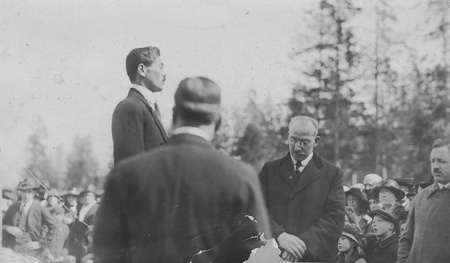


In 1925, the veterans were organised as the Japanese Branch of the Canadian Legion (B.C. Branch 9). In 1931, the leaders of Legion Branch 9 included veterans Sergeant Masumi Mitsui as president, Corporal Sainosuke Kubota as secretary and Saburo as advisor. According to Ken Adachi’s book, The Enemy that Never Was, Saburo Shinobu led the fight for the franchise for WWI veterans.
He began agitating before 1920 among many organizations throughout the province regarding the securing of the franchise for the Japanese veterans. When the matter of the revision of the provincial franchise was brought up at the Provincial Legislative Assembly, he secured assertions of support from the Members of the Assembly from many ridings1.
On April 1, 1931, Mitsui, Kubota, Shinobu and veteran Noboru Murakami went to the Legislature in Victoria to seek the franchise for the veterans, with the help of other Legion members. The group met with every member of the Legislature to promote their cause.
The WWI veterans did gain the franchise from the B.C. government and the federal government on that day, but only the veterans were given this privilege (not their descendants), and they earned it with only one single vote breaking a deadlock. The four Japanese Canadians wept with relief when they heard the news; it had been a 12-year struggle to reach that goal and they were sleep-deprived and under great emotional stress. Receiving a heroes’ welcome when they returned to Vancouver, they drove directly to the Japanese Canadian War Memorial in Stanley Park to honour the fallen WW1 soldiers. Saburo later became the seventh Canadian to be named an honorary life member of the Canadian Legion, the highest honour conferred by the organization.
Photo E was taken in 1939 in front of the Japanese War Memorial in Stanley Park, Vancouver. This included the Japanese veterans of WW1 who formed the Legion Branch 9 and who were honour guards for the visiting King and Queen. Mitsui, Kubota and Shinobu are identified in Photo E, plus Lt. Col. Nelson Spencer, the Member of the Legislative Assembly for Vancouver who supported their bid for the franchise in 1931. He had been the commander of a battalion in WW1 that included many Japanese Canadian soldiers.
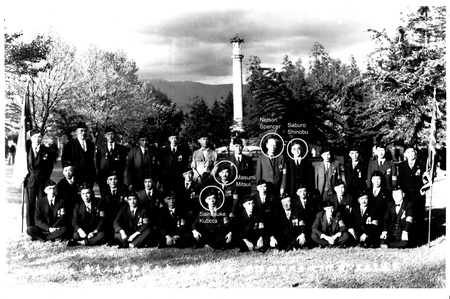
Note:
1. A riding is an administrative jurisdiction or electoral district.
*This article was originally published in Nikkei Images, Fall 2016, Vol. 21, No. 3.
© 2016 Susan Yatabe & Kazuko Yatabe



